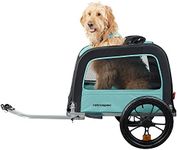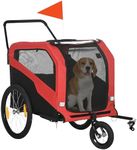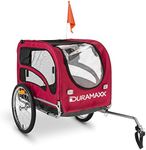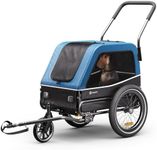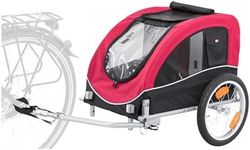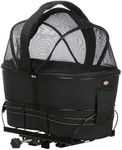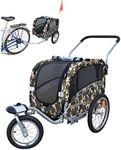Buying Guide for the Best Dog Bicycle Carriers
Choosing the right dog bicycle carrier is essential for ensuring the safety and comfort of both you and your furry friend during your biking adventures. When selecting a carrier, consider factors such as your dog's size, weight, and temperament, as well as your own biking habits and preferences. A well-chosen carrier will provide a secure and comfortable space for your dog, allowing you both to enjoy the ride without worry.Size and Weight CapacitySize and weight capacity are crucial when selecting a dog bicycle carrier because they determine whether the carrier can safely accommodate your dog. Carriers come in various sizes, typically ranging from small to large, and each has a maximum weight limit. Small carriers are suitable for dogs up to 15 pounds, medium carriers can hold dogs between 15 and 30 pounds, and large carriers are designed for dogs over 30 pounds. To choose the right size, measure your dog's height, length, and weight, and ensure the carrier can comfortably fit your dog without being too cramped.
Material and DurabilityThe material and durability of a dog bicycle carrier are important for ensuring it can withstand regular use and provide a safe environment for your dog. Common materials include fabric, plastic, and metal, each offering different levels of durability and comfort. Fabric carriers are lightweight and comfortable but may not be as durable as plastic or metal options. Plastic carriers are sturdy and easy to clean, while metal carriers offer the highest durability but can be heavier. Consider your dog's behavior and the frequency of use when choosing the material; active dogs or frequent riders may benefit from more durable options.
Safety FeaturesSafety features in a dog bicycle carrier are essential to protect your dog during rides. These features can include harness attachments, reflective strips, and secure closures. Harness attachments help keep your dog securely in place, preventing them from jumping out or moving around too much. Reflective strips enhance visibility, especially during low-light conditions, ensuring you and your dog are seen by other road users. Secure closures, such as zippers or buckles, prevent accidental openings. Evaluate your biking environment and choose a carrier with safety features that match your needs, especially if you ride in busy or low-light areas.
VentilationVentilation is important in a dog bicycle carrier to ensure your dog remains comfortable and cool during rides. Proper ventilation prevents overheating and allows fresh air to circulate, which is particularly important during warm weather. Carriers with mesh panels or windows provide good airflow while still keeping your dog secure. If you plan to ride in hot climates or during summer months, prioritize carriers with ample ventilation to keep your dog comfortable and safe.
Ease of Installation and UseEase of installation and use is a key consideration when choosing a dog bicycle carrier, as it affects how quickly and conveniently you can set up and use the carrier. Some carriers are designed for easy attachment to the bike, with quick-release mechanisms or simple straps, while others may require more complex installation. Consider your own technical skills and how often you plan to use the carrier; if you need to frequently attach and detach the carrier, opt for a model that offers straightforward installation and user-friendly features.


